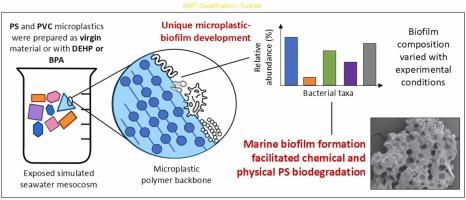生物膜的发展是推动海洋微塑料降解的一个因素
IF 11.3
1区 环境科学与生态学
Q1 ENGINEERING, ENVIRONMENTAL
引用次数: 0
摘要
海洋天然生物污垢促进微塑料的生物降解是一种很有前景的海洋生物修复方法。然而,实施需要全面了解海洋微生物组与主要微塑料碎片类型(例如聚合物和添加剂组合)之间的相互作用如何影响生物膜的发育并推动生物降解。为了研究这一点,聚苯乙烯(PS)和聚氯乙烯(PVC)微塑料(<;直径为200µm),制备时不添加任何添加剂(即未添加)或含有15%的增塑剂邻苯二甲酸二乙基己酯(DEHP)或双酚A (BPA)。每种聚合物-增塑剂微塑料组合都暴露在具有代表性的热带珊瑚礁水域的模拟海水中游环境中,为期21天,以允许自然生物膜发育。随后,利用红外、热、凝胶渗透和表面表征技术,以及16S核糖体RNA细菌基因测序,分别评估微塑料降解和定植细菌生物膜随时间、聚合物和增塑剂类型的函数。总之,这些分析揭示了时间,聚合物和增塑剂依赖的降解,特别是PS-BPA微塑料。PS-BPA微塑料的降解也与细菌群落组成的变化和假定的生物降解细菌的总相对丰度的增加相一致。这些发现表明,即使在短时间内,定殖海洋生物膜的代谢潜力和生物降解能力也会受到微塑料基质化学性质的显著影响。本文章由计算机程序翻译,如有差异,请以英文原文为准。

Biofilm development as a factor driving the degradation of plasticised marine microplastics
Biodegradation of microplastics facilitated by natural marine biofouling is a promising approach for ocean bioremediation. However, implementation requires a comprehensive understanding of how interactions between the marine microbiome and dominant microplastic debris types (e.g., polymer and additive combinations) can influence biofilm development and drive biodegradation. To investigate this, polystyrene (PS) and polyvinyl chloride (PVC) microplastics (< 200 µm in diameter) were prepared either without any additives (i.e., virgin) or containing 15 wt% of the plasticisers diethylhexyl phthalate (DEHP) or bisphenol A (BPA). Each polymer-plasticiser microplastic combination was exposed to environmentally relevant conditions in a simulated seawater mesocosm representative of tropical reef waters over a 21-day period to allow for natural biofilm development. Following this, microplastic degradation and the colonising bacterial biofilm was assessed as a function of time, polymer and plasticiser type using infrared, thermal, gel permeation and surface characterisation techniques, as well as 16S ribosomal RNA bacterial gene sequencing, respectively. Together, these analyses revealed time-, polymer- and plasticiser-dependent degradation, particularly of the PS-BPA microplastics. Degradation of the PS-BPA microplastics also coincided with changes in bacterial community composition and an increased total relative abundance of putative biodegradative bacteria. These findings indicate that the metabolic potential and biodegradative capability of the colonising marine biofilm can be significantly impacted by the chemical properties of the microplastic substrate, even within short timeframes.
求助全文
通过发布文献求助,成功后即可免费获取论文全文。
去求助
来源期刊

Journal of Hazardous Materials
工程技术-工程:环境
CiteScore
25.40
自引率
5.90%
发文量
3059
审稿时长
58 days
期刊介绍:
The Journal of Hazardous Materials serves as a global platform for promoting cutting-edge research in the field of Environmental Science and Engineering. Our publication features a wide range of articles, including full-length research papers, review articles, and perspectives, with the aim of enhancing our understanding of the dangers and risks associated with various materials concerning public health and the environment. It is important to note that the term "environmental contaminants" refers specifically to substances that pose hazardous effects through contamination, while excluding those that do not have such impacts on the environment or human health. Moreover, we emphasize the distinction between wastes and hazardous materials in order to provide further clarity on the scope of the journal. We have a keen interest in exploring specific compounds and microbial agents that have adverse effects on the environment.
 求助内容:
求助内容: 应助结果提醒方式:
应助结果提醒方式:


